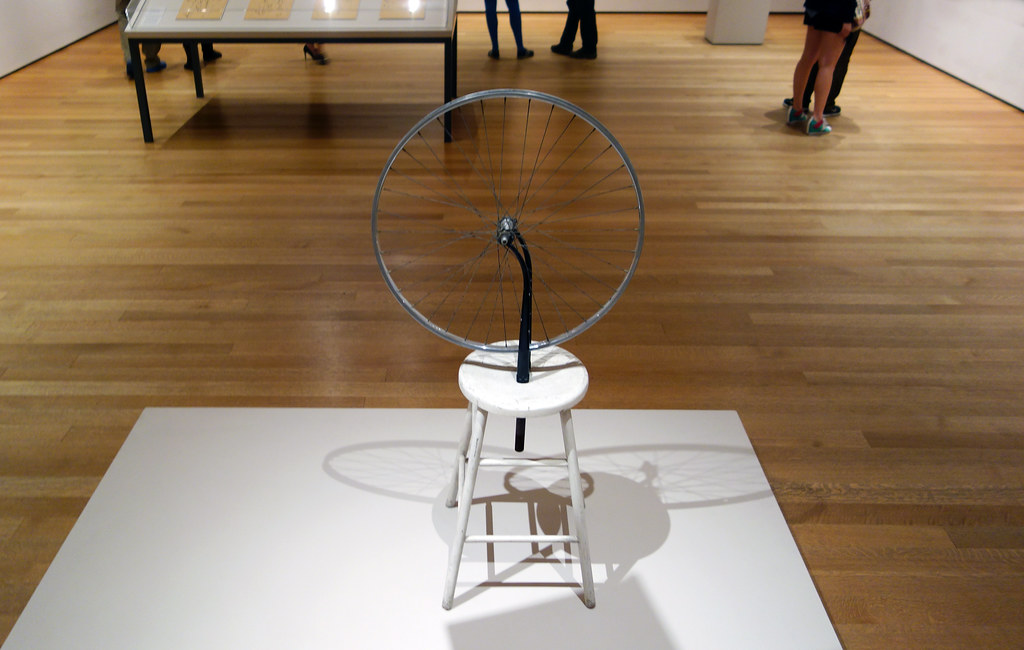Marcel Duchamp’s “Bicycle Wheel” is often regarded as one of the most iconic and groundbreaking works of modern art. Created in 1913, this piece marks the advent of the “readymade,” a term coined by Duchamp to describe ordinary objects elevated to the status of art. Consequently, “Bicycle Wheel” challenges traditional notions of art and aesthetics, sparking intense debates and discussions that continue to this day. Therefore, this comprehensive guide explores the origins, significance, artistic context, and enduring legacy of Duchamp’s “Bicycle Wheel.” By delving into these aspects, you can appreciate the revolutionary impact of this seminal work and understand its profound influence on contemporary art.
Origins and Creation of “Bicycle Wheel”
The creation of “Bicycle Wheel” marked a pivotal moment in Duchamp’s artistic journey and in the history of modern art. Understanding its origins provides valuable insight into the thought process behind this groundbreaking work. Therefore, exploring the origins and creation of “Bicycle Wheel” is essential.

Conceptual Genesis
The conceptual genesis of “Bicycle Wheel” can be traced back to Duchamp’s fascination with challenging conventional art practices. Disenchanted with the traditional methods of painting and sculpting, Duchamp sought new ways to express his avant-garde ideas. In 1913, he combined a simple bicycle wheel with a wooden stool, creating the first of his many readymades. This act of transforming an everyday object into a piece of art was a radical departure from the norm, questioning the very nature of art itself. By understanding this conceptual genesis, we see how “Bicycle Wheel” encapsulates Duchamp’s innovative spirit. Therefore, recognizing the origins of the piece highlights its revolutionary essence.
Assembling the Artwork
The actual assembly of “Bicycle Wheel” was a straightforward process, yet its implications were profound. Duchamp took an ordinary front bicycle wheel and mounted it onto the seat of a wooden stool. Contrary to intricate artistry, this simple combination of objects represented a deliberate and thought-provoking artistic choice. Duchamp’s goal was not to create something visually appealing, but to challenge the viewers’ perceptions and provoke contemplation. The choice of a utilitarian object, devoid of traditional aesthetics, was central to Duchamp’s critique of art. By understanding the assembly process, we appreciate the deliberate simplicity and intellectual depth of “Bicycle Wheel.” Therefore, recognizing the assembly underscores the thought-provoking nature of the work.
Significance and Artistic Context
The significance of “Bicycle Wheel” extends far beyond its physical form, impacting the art world and influencing subsequent generations of artists. Understanding its artistic context enriches our appreciation of its revolutionary impact. Therefore, exploring the significance and context of “Bicycle Wheel” is crucial.

Challenging Artistic Norms
“Bicycle Wheel” challenges artistic norms by defying conventional definitions of art. Traditional art was often associated with skill, craftsmanship, and aesthetic appeal. However, Duchamp’s readymades, including “Bicycle Wheel,” disrupted these conventions, suggesting that art could be anything an artist deemed it to be. This radical idea opened new avenues for artistic expression, prioritizing concept over execution. By challenging the established norms, Duchamp questioned the role of the artist and the nature of artistic creation. This shift in perspective had a profound impact on the evolution of modern art. Therefore, understanding how “Bicycle Wheel” challenged norms highlights its significance.
Influence on Future Art Movements
The influence of “Bicycle Wheel” on future art movements cannot be overstated. Duchamp’s readymades laid the groundwork for various avant-garde movements, including Dada, Surrealism, and Conceptual Art. These movements embraced the idea of elevating ordinary objects to the status of art, focusing on intellectual engagement and social critique. The legacy of “Bicycle Wheel” can be seen in the works of artists such as Salvador Dalí, Andy Warhol, and Jeff Koons, who continued to explore the boundaries of art and its definitions. By understanding its influence, we recognize the far-reaching impact of “Bicycle Wheel” on the trajectory of contemporary art. Therefore, recognizing its influence underscores the work’s enduring relevance.
Reception and Controversy
The reception of “Bicycle Wheel” was marked by both admiration and controversy, reflecting its provocative nature. Understanding the reactions it elicited offers valuable insights into the cultural and artistic climate of the time. Therefore, exploring the reception and controversy surrounding “Bicycle Wheel” is essential.
Initial Reactions
When “Bicycle Wheel” was first introduced, it elicited a wide range of reactions from the art community and the public. Some critics and artists lauded Duchamp’s ingenuity and boldness, recognizing the intellectual depth of his work. Others, however, dismissed the readymade as a mere provocation or a gimmick, struggling to accept it as legitimate art. This divide highlighted the tension between traditional artistic values and emerging avant-garde approaches. By understanding these initial reactions, we see how “Bicycle Wheel” sparked intense debates and challenged prevailing attitudes toward art. Therefore, recognizing the initial reception underscores the work’s provocative impact.

Ongoing Controversy
The controversy surrounding “Bicycle Wheel” did not subside with time; rather, it continued to fuel discussions about the nature and purpose of art. Critics questioned whether Duchamp’s readymades undermined the value of artistic skill and creativity. Supporters, on the other hand, argued that Duchamp’s work expanded the boundaries of art and encouraged new modes of thinking. The ongoing controversy reflects the enduring relevance and contentious nature of Duchamp’s ideas. By understanding the ongoing debate, we appreciate how “Bicycle Wheel” remains a focal point for discussions about art and its definitions. Therefore, recognizing the controversy highlights the work’s lasting influence.
The Legacy of “Bicycle Wheel”
The legacy of “Bicycle Wheel” extends far beyond its creation, impacting the art world and shaping contemporary artistic practices. Understanding its enduring legacy provides valuable insights into its significance. Therefore, exploring the legacy of “Bicycle Wheel” is crucial.
Establishing the Concept of Readymades
One of the most significant contributions of “Bicycle Wheel” is the establishment of the concept of readymades. Duchamp’s innovative idea of transforming everyday objects into art challenged traditional notions of artistic creation. This concept paved the way for future artists to explore unconventional materials and methods, emphasizing the importance of context and intention. The readymade became a pivotal element in the development of modern and contemporary art, influencing various movements and artists. By understanding this legacy, we recognize the profound impact of Duchamp’s pioneering vision. Therefore, recognizing the establishment of readymades underscores the work’s transformative influence.
Inspire Future Generations of Artists
“Bicycle Wheel” has inspired countless artists to push the boundaries of creativity and challenge conventional definitions of art. Duchamp’s radical approach encouraged artists to explore new media, concepts, and forms of expression. The influence of “Bicycle Wheel” can be seen in the works of contemporary artists who continue to experiment with found objects, installations, and conceptual art. By understanding its inspirational legacy, we appreciate how “Bicycle Wheel” continues to shape and inspire the art world. Therefore, recognizing its impact on future generations highlights the enduring relevance of Duchamp’s work.

Common Misconceptions About “Bicycle Wheel”
Addressing common misconceptions about “Bicycle Wheel” provides clarity and deepens our understanding of this groundbreaking work. Dispelling these myths ensures a more accurate appreciation of its significance. Therefore, exploring common misconceptions is important.
Misconception: It’s Just a Bicycle Wheel on a Stool
One common misconception is that “Bicycle Wheel” is merely a bicycle wheel mounted on a stool, devoid of artistic merit. In reality, the significance of “Bicycle Wheel” lies in the conceptual innovation behind it. Duchamp’s choice to elevate ordinary objects to the status of art challenges traditional definitions and encourages intellectual engagement. By understanding the conceptual depth, we see beyond the physical form and appreciate the revolutionary nature of the work. Therefore, dispelling this misconception highlights the intellectual and artistic significance of “Bicycle Wheel.”
Misconception: Readymades Diminish Artistic Skill
Another misconception is that readymades, including “Bicycle Wheel,” diminish the value of artistic skill and creativity. While Duchamp’s readymades prioritize concept over craftsmanship, they do not undermine the value of skill. Instead, they expand the definition of art to include the artist’s intention and context. By challenging traditional notions, readymades encourage new perspectives and forms of artistic expression. Understanding this broader context allows us to appreciate the innovative nature of Duchamp’s work. Therefore, dispelling this misconception emphasizes the importance of intention and context in art.

Conclusion: The Enduring Impact of Marcel Duchamp’s “Bicycle Wheel”
Marcel Duchamp’s “Bicycle Wheel” stands as a groundbreaking work that has profoundly impacted the world of modern art. Understanding its origins and conceptual genesis reveals the innovative spirit behind Duchamp’s creation.
Exploring the significance and artistic context of “Bicycle Wheel” highlights its role in challenging traditional artistic norms and influencing future art movements. The reception and controversy surrounding the work underscore its provocative nature and enduring relevance.
Recognizing the legacy of “Bicycle Wheel,” including the establishment of readymades and its inspiration to future generations, emphasizes its transformative influence on contemporary art. Addressing common misconceptions provides clarity and deepens our appreciation of Duchamp’s revolutionary ideas.
By embracing these aspects, we can fully appreciate the enduring impact of “Bicycle Wheel” and its significance in the history of art. Therefore, whether you are an art enthusiast or a curious observer, understanding the revolutionary essence of “Bicycle Wheel” enhances your comprehension and appreciation of modern art. Enjoy the intellectual and artistic exploration inspired by this seminal work, recognizing its profound influence on the world of art!


